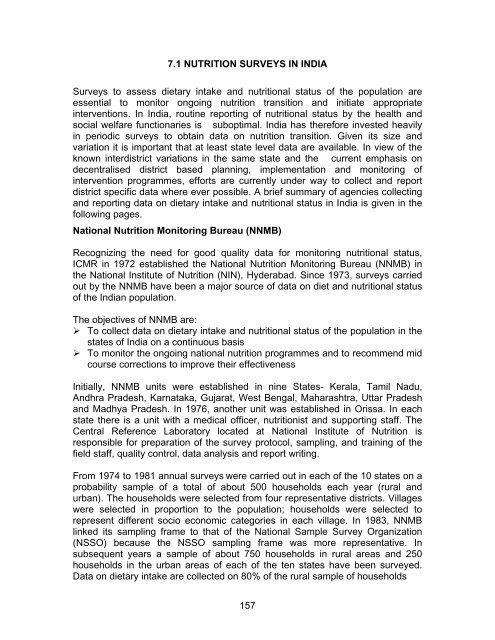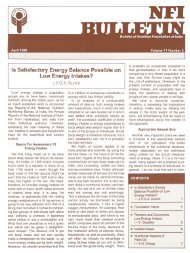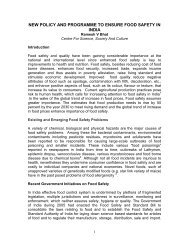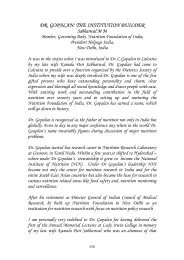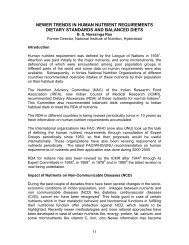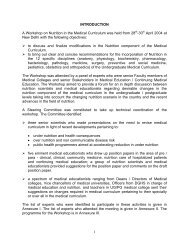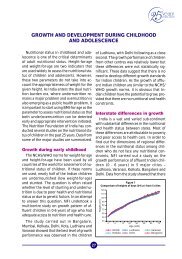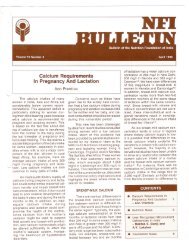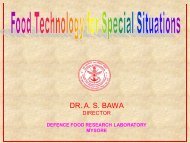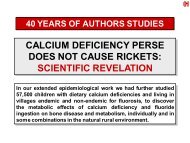Nutrition Surveys in India - Ministry of Women and Child Development
Nutrition Surveys in India - Ministry of Women and Child Development
Nutrition Surveys in India - Ministry of Women and Child Development
- No tags were found...
You also want an ePaper? Increase the reach of your titles
YUMPU automatically turns print PDFs into web optimized ePapers that Google loves.
Table 7.1.1: Particulars <strong>of</strong> coverage <strong>of</strong> repeat rural surveysus<strong>in</strong>g one-day weighment method on the day <strong>of</strong> survey. In the rema<strong>in</strong><strong>in</strong>g 20% <strong>of</strong>households <strong>in</strong>dividual dietary <strong>in</strong>takes are assessed us<strong>in</strong>g a s<strong>in</strong>gle 24-hour recallfor estimat<strong>in</strong>g <strong>in</strong>tra-familial distribution <strong>of</strong> food. NNMB had carried out surveys <strong>in</strong>1975-79, 1980-85, 1988-90, 1996-97, 2000-01 <strong>and</strong> 2004-05 <strong>in</strong> rural areas <strong>and</strong> <strong>in</strong>1975-79 <strong>and</strong> 1993-94 <strong>in</strong> urban areas.In order to get time trends <strong>in</strong> dietary <strong>in</strong>take <strong>and</strong> nutritional status <strong>in</strong> ruralpopulation, the NNMB carried out two repeat surveys <strong>in</strong> 1988-90 <strong>and</strong> <strong>in</strong> 1996-97,<strong>of</strong> the rural areas surveyed <strong>in</strong> 1975-79. Over 100 villages <strong>in</strong> each state werecovered <strong>in</strong> all the three surveys with sixty villages be<strong>in</strong>g common between repeatsurveys. Table 7.1.1 gives the coverage under the two rural repeat surveyscarried out by NNMB. In 2000, us<strong>in</strong>g data from the above surveys, NNMBproduced separate reports on dietary <strong>in</strong>take <strong>and</strong> nutritional status <strong>of</strong> adolescents(10 to 17 years <strong>of</strong> age) <strong>and</strong> elderly (60+ years).<strong>India</strong> has a large tribal population <strong>and</strong> hence a special tribal survey has beencarried out by NNMB dur<strong>in</strong>g the years 1985-87 <strong>and</strong> the first repeat survey <strong>of</strong> thissample was done <strong>in</strong> 1998-99. In <strong>India</strong>, droughts cont<strong>in</strong>ue to be a problem <strong>in</strong>several drought prone districts. NNMB has carried out surveys <strong>in</strong> droughtaffectedareas over years. The most recent one was a survey <strong>in</strong> n<strong>in</strong>e statesaffected by drought <strong>in</strong> the current decade. The drought surveys provide<strong>in</strong>formation on impact <strong>of</strong> drought <strong>and</strong> the relief operation on nutritional status <strong>of</strong>the population.<strong>India</strong> <strong>Nutrition</strong> Pr<strong>of</strong>ile (INP) Survey<strong>Nutrition</strong>assessmentNo. <strong>of</strong> villages surveyed Households *State 75-79 88-90 96-97 75-79 88-90 96-90 96-97Kerala 106 91 119 979 835 1180 8,864Tamilnadu 110 96 54 978 865 530 5,813Karnataka 167 126 112 999 783 1020 12,606AP 136 119 115 1071 908 1142 9,545Maharashtra 126 128 85 615 837 824 6,883Gujarat 120 116 83 697 711 791 4,866MP 55 50 36 234 255 - -Orissa 98 156 109 524 824 1064 12,024Pooled 918 882 713 6497 6018 6,551 60,601* Covered for diet surveySource: Reference 7.1.7Food & <strong>Nutrition</strong> Bureau <strong>in</strong> the Department <strong>of</strong> <strong>Women</strong> & <strong>Child</strong> <strong>Development</strong> <strong>of</strong>NorthernRegionTable 7.1.2: States <strong>and</strong> UTs covered <strong>in</strong> the surveyStates / UTsHaryana*, Himachal Pradesh*, Punjab*, Rajasthan, Ch<strong>and</strong>igarh, DelhiEasternBihar, Sikkim.North EasternArunachal*, Assam*, Manipur, Meghalaya, Mizoram, Nagal<strong>and</strong>*, TripuraWesternDadra & Nagar Haveli*, Daman & Diu*, Goa,* In these States/UTs only rural areas were covered158
the M<strong>in</strong>istry <strong>of</strong> Human Resource <strong>Development</strong> <strong>of</strong> the Government <strong>of</strong> <strong>India</strong>organized a survey <strong>in</strong> 1995-96 to obta<strong>in</strong> a reliable nutrition pr<strong>of</strong>ile <strong>of</strong> all districts(<strong>India</strong> nutrition pr<strong>of</strong>ile INP) <strong>in</strong> 18 States <strong>and</strong> Union Territories <strong>in</strong> which NNMB wasnot conduct<strong>in</strong>g nutrition surveys (Table 7.1.2). The INP survey used sampl<strong>in</strong>gdesign <strong>and</strong> survey methodologies similar to NNMB. Overall 187 districts werecovered <strong>in</strong> 18 states <strong>and</strong> UTs. INP provides data on dietary <strong>in</strong>take <strong>and</strong> nutritionalstatus <strong>of</strong> all age groups, <strong>in</strong> all states <strong>of</strong> the country, <strong>in</strong> urban <strong>and</strong> rural areas <strong>in</strong>mid n<strong>in</strong>eties.Both NNMB <strong>and</strong> INP surveys have used 24-hour dietary recall for assessment <strong>of</strong>dietary <strong>in</strong>take. The amounts consumed were compared with the RecommendedDietary Allowance (RDA) for <strong>India</strong>ns drawn up by the <strong>India</strong>n Council <strong>of</strong> MedicalResearch (ICMR) published <strong>in</strong> 1989 (ICMR 1989). Household food <strong>in</strong>takeobta<strong>in</strong>ed by 24-hour dietary recall is used to compute the average <strong>in</strong>take <strong>of</strong> thehousehold members expressed per consumption unit (CU) per day (NNMB1981). The Consumption Unit for different age <strong>and</strong> sex groups were worked outon the basis <strong>of</strong> the energy requirements by tak<strong>in</strong>g the energy consumption <strong>of</strong> anaverage adult male do<strong>in</strong>g sedentary work as one consumption unit (Text Box7.1.1).Computation <strong>of</strong> nutrient <strong>in</strong>takeNutrient <strong>in</strong>take is computed us<strong>in</strong>g Nutritive Value <strong>of</strong> <strong>India</strong>n Foods (NIN, 2004),which was first, published <strong>in</strong> 1971. S<strong>in</strong>ce then it has undergone many repr<strong>in</strong>ts.Analysis <strong>of</strong> iron content <strong>of</strong> <strong>India</strong>n food stuffs by newer techniques have shownthat the available iron is only about 50 percent <strong>of</strong> the earlier values reported <strong>and</strong>hence <strong>in</strong> the latest edition values for iron content have been revised.Assessment <strong>of</strong> nutritional statusBoth these surveys report data on prevalence <strong>of</strong> chronic energy deficiency <strong>in</strong> allage groups. For children, the data is reported us<strong>in</strong>g the follow<strong>in</strong>g threeclassifications:Text Box 7.1.1: Consumption UnitAdult male (Sedentary worker) 1.0Adult male (Moderate worker) 1.2Adult male (Heavy worker) 1.6Adult female (Sedentary) 0.8Adult female (Moderate) 0.9Adult female (Heavy) 1.2Adolescent – 12 to 21 years 1.0<strong>Child</strong>ren – 9 to 12 years 0.8<strong>Child</strong>ren – 7 to 9 years 0.7<strong>Child</strong>ren – 5 to 7 years 0.6<strong>Child</strong>ren – 3 to 5 years 0.5<strong>Child</strong>ren – 1 to 3 years 0.4Source: Reference 7.1.7Table 7.1.3: z score <strong>and</strong> percentile classificationsystem<strong>Nutrition</strong>alstatusz-scores PercentilesNormalMildModerate-1 <strong>and</strong> +1 SDMedian≥ -2 <strong>and</strong> +1 <strong>and</strong> +2 SD-1 SD <strong>and</strong> +1 SD≥-3 <strong>and</strong> +2 <strong>and</strong> +3 SD-2 SD <strong>and</strong> +2 SD< -3 or > + 3 SDSevere-3 SD <strong>and</strong> +3 SDSource: Reference 7.1.1015 th to 85 th percentile50 th percentile3 rd to 15 th or85 th to 97 th percentile3 rd <strong>and</strong> 85 th percentiles< 3 rd or >97 th percentiles3 rd <strong>and</strong> 97 th percentiles159
Table 7.1.4: IAP system <strong>of</strong> classificationGrades <strong>of</strong>ValueundernutritionNormalMild UN (Gr I)Moderate UN (Gr II)Severe UN (Gr III)Very severe UN (GrIV)Source: Reference 7.1.7≥ 80 % medianBetween 80 % & 70 % <strong>of</strong> med.Between 70 % & 60 % <strong>of</strong> med.Between 60 % & 50 % <strong>of</strong> med.Less than 50 % <strong>of</strong> med.Table 7.1.5: Gomez ClassificationWeight for age(% <strong>of</strong> NCHSst<strong>and</strong>ard)<strong>Nutrition</strong>al Grade>= 90 Normal75-89.9 Grade I (mild UN)60-74.9Grade II (moderateUN)• St<strong>and</strong>ard Deviation (SD) Classification (toenable <strong>in</strong>ternational comparison) (Table7.1.3)< 60 Grade III (severe UN)• <strong>India</strong>n Academy <strong>of</strong> Paediatrics (IAP) Classification (to compare the data withthe Integrated <strong>Child</strong> <strong>Development</strong> Scheme – (ICDS), reported data on undernutrition) (Table 7.1.4)• Gomez Classification (to enable comparison with data perta<strong>in</strong><strong>in</strong>g to seventies<strong>and</strong> early eighties) (Table 7.1.5)In April 2006, WHO came up with the growth norms for preschool children basedon multicentre global data from breastfed <strong>in</strong>fants <strong>and</strong> recommended thatassessment <strong>of</strong> nutritional status <strong>of</strong> the preschool children. The WHO st<strong>and</strong>ardsgive BMI-for-age, which is useful for detect<strong>in</strong>g both undernutrition <strong>and</strong> obesity,thus address<strong>in</strong>g the double burden <strong>of</strong> malnutrition.National Family Health Survey (NFHS)Three National Family Health <strong>Surveys</strong> NFHS-1 conducted <strong>in</strong> 1992–93, NFHS-2conducted <strong>in</strong> 1998–99 <strong>and</strong> NFHS-3 conducted <strong>in</strong> 2004-05 provide national <strong>and</strong>state-level <strong>in</strong>formation on fertility, family plann<strong>in</strong>g, <strong>in</strong>fant <strong>and</strong> child mortality,reproductive health, child health, nutrition <strong>of</strong> women <strong>and</strong> children, <strong>and</strong> the quality<strong>of</strong> health <strong>and</strong> family welfare services. These surveys also provides estimates atthe regional level for four states (Bihar, Madhya Pradesh, Rajasthan, <strong>and</strong> UttarPradesh) <strong>and</strong> estimates for three metro cities (Calcutta, Chennai, <strong>and</strong> Mumbai),as well as slum areas <strong>in</strong> Mumbai. The NFHS-2 sample covers more than 99percent <strong>of</strong> <strong>India</strong>’s population liv<strong>in</strong>g <strong>in</strong> all 26 states. It does not cover the unionterritories. NFHS-2 is a household survey with an overall target sample size <strong>of</strong>approximately 90,000 ever-married women <strong>in</strong> the age group 15–49. Data onnutritional status <strong>of</strong> women <strong>and</strong> children from NHFS 1, 2 <strong>and</strong> 3 provide<strong>in</strong>formation on time trends <strong>in</strong> prevalence <strong>of</strong> undernutrition <strong>in</strong> the last 15 years. Inaddition, NFHS -2 provides <strong>in</strong>formation on dietary diversity among the womensurveyed.160
District Level Household SurveyThis survey is conducted by the Department <strong>of</strong> Family Welfare to assessperformance under the Reproductive <strong>and</strong> <strong>Child</strong> Health programme. The firstround was conducted <strong>in</strong> 1998-99 <strong>and</strong> the second round <strong>of</strong> the survey wasconducted between 2002 <strong>and</strong> 2004. The survey used a systematic multi-stagestratified sampl<strong>in</strong>g; stages <strong>of</strong> selection are districts, primary sampl<strong>in</strong>g units(PSUs) <strong>and</strong> households; 1000 representative households were identified for thesurvey us<strong>in</strong>g appropriate sampl<strong>in</strong>g procedure from each district. Thirty percent <strong>of</strong>the sample was from urban areas <strong>and</strong> were based on NSSO urban sampl<strong>in</strong>gframe. The survey provides district level <strong>in</strong>formation on prevalence <strong>of</strong>undernutrition (weight for age us<strong>in</strong>g the SD classification) <strong>in</strong> children <strong>in</strong> the agegroup 0-72 months, prevalence <strong>of</strong> anaemia (Hb estimation bycyanmethaemoglob<strong>in</strong> method) <strong>in</strong> children (0-72 months), adolescent girls (10-19yrs) <strong>and</strong> pregnant women, household availability <strong>of</strong> iodised salt <strong>and</strong> coverageunder the massive dose vitam<strong>in</strong> A programme.Micronutrients <strong>Surveys</strong>NNMB <strong>and</strong> ICMR have conducted micronutrient surveys at subnational leveldur<strong>in</strong>g the last few years. In addition, NFHS <strong>and</strong> DLHS provide <strong>in</strong>formation onthe household availability <strong>of</strong> iodised salt <strong>and</strong> coverage under massive dosevitam<strong>in</strong> A programme. NHFS-2 <strong>and</strong> 3 undertook haemoglob<strong>in</strong> estimation <strong>in</strong>women <strong>and</strong> children but the method used (haemocue) has been shown tooverestimate haemoglob<strong>in</strong> <strong>and</strong> consequently underestimate the prevalence <strong>of</strong>anaemia.References7.1.1 District Level Household Survey http://www.rch<strong>in</strong>dia.org/dlhs_<strong>in</strong>dia.htm; last accessed on24/09/077.1.2 Department <strong>of</strong> <strong>Women</strong> <strong>and</strong> <strong>Child</strong> <strong>Development</strong>. 1995-96. <strong>India</strong>n <strong>Nutrition</strong> Pr<strong>of</strong>ile.Government <strong>of</strong> <strong>India</strong>, New Delhi7.1.3 <strong>India</strong>n Council <strong>of</strong> Medical Research. 1989. Nutrient Requirements <strong>and</strong> RecommendedDietary allowances for <strong>India</strong>ns. New Delhi7.1.4 National Family Health Survey (NFHS-1): http://www.nfhs<strong>in</strong>dia.org/<strong>in</strong>dia1.html; lastaccessed on 24/09/077.1.5 National Family Health Survey (NFHS-2): http://www.nfhs<strong>in</strong>dia.org/<strong>in</strong>dia2.html; lastaccessed on 24/09/077.1.6 National Family Health Survey (NFHS-3): http://mohfw.nic.<strong>in</strong>/nfhsfactsheet.htm; lastaccessed on 24/09/077.1.7 NNMB National <strong>Nutrition</strong> Monitor<strong>in</strong>g Bureau. 1979-2002. NNMB Reports: NationalInstitute Of <strong>Nutrition</strong>, Hyderabad7.1.8 National Institute <strong>of</strong> <strong>Nutrition</strong>. 2004. Nutritive Value <strong>of</strong> <strong>India</strong>n Foods. Hyderabad.7.1.9 National Sample Survey Organization NSSO. 1975-2000.;http://mospi.nic.<strong>in</strong>/mospi_nsso_rept_pubn.htm; last accessed on 24/09/077.1.10 WHO child growth st<strong>and</strong>ards, 2006: http://www.who.<strong>in</strong>t/childgrowth/en/ : last accessedon 24/09/07161


